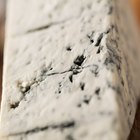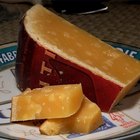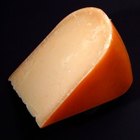
Cheese in almost any form is nutritious and tasty, though it's admittedly a bit too high in sodium and fat for unrestrained consumption. That potent combination of tastiness and indulgence makes cheese a near-perfect party food, from slivers of Parmigiano-Reggiano to colorful and strongly flavored cheese balls. Cheeses in general are long-lasting foods, though cheese balls are a special case because they include many flavoring ingredients.
Cheese Ball Anatomy
Given the thousands of cheeses in the world, the number of possible cheese ball recipes is all but unlimited. Still, most conform to the same broad description. One or more strongly flavored cheeses is finely shredded, then mixed into a base of softened cream cheese or a similarly soft, spreadable cheese. Fresh herbs, spices, dried fruits and seeds or nuts can all be added to provide complementary or contrasting flavors, and some recipes add a splash of alcohol. The finished ball is usually rolled in seeds, crushed nuts or freshly ground spices, to provide a visually appealing exterior.
Commercially Made Cheese Balls
If you purchase your cheese balls at the supermarket, their shelf life is relatively straightforward. They're manufactured in tightly inspected production facilities, then packaged in airtight plastic and -- usually -- stamped with a "best before" date that's weeks or even months in the future. This is intended to tell you how long the cheese ball will retain its best freshness and flavor. The date is a reasonably reliable guide, but it assumes the cheese ball has been kept refrigerated throughout its life. If it was permitted to warm to room temperature at any point, it can spoil before its freshness date expires. Use common sense, and be alert for any signs of mold, fluid discharge or unpleasant odors.
Homemade Cheese Balls
Your homemade cheese balls don't have the benefit of sterile packaging and production, so they won't last as long as a commercial product. The rule of thumb for cheese balls, dips and similar products is that they'll last as long as your most perishable ingredient. The main ingredient in a cheese ball is cream cheese, which ordinarily lasts for a week or two in the fridge once it's opened. If you've used fresh herbs, diced fruit, cream or other perishable ingredients, the storage life of your cheese ball might be as little as 24 to 48 hours.
Party Time
Once you unwrap your cheese ball and set it out for guests, your focus should shift from shelf life to food safety. Potentially harmful microorganisms multiply rapidly at room temperature in highly nutritious foods such as cheese, so pay careful attention to the time when you set out your cheese ball. After two hours, any unused portions should be discarded, for safety's sake. Rather than making one large cheese ball, consider making two or more smaller balls or logs and bring them out over the course of the event. Have a steady supply of clean or disposable utensils, and change them as often as needed to prevent contaminating the cheese.
Related Articles

Calories in Bocconcini Cheese
Easy Cheese Ball Recipe

How to Easily Put the Ball on a Lip Ring

What Types of Cheeses Are Unpasteurized?

What Good Bacteria Is in Cheese?

How to Store Cheese

Facts About Gouda Cheese

What Happens to Cream Cheese if It's ...

Do You Thaw Frozen Cheese Before ...

Does a Sliced American Cheese Product ...

Does Blue Cheese Spoil?

How to Freeze Cheeses

What Is Animal Rennet?

What Type of Microorganism Is Used to ...

Cheese Fountain Ideas
How Long Can I Store Grated Pecorino ...

Can You Substitute Mascarpone With ...

How to Store Parmesan Cheese

How to Store a Cheese Wheel With a Wax ...

How to Take the Ball Off of a Lip Ring
References
Resources
Writer Bio
Fred Decker is a trained chef and prolific freelance writer. In previous careers, he sold insurance and mutual funds, and was a longtime retailer. He was educated at Memorial University of Newfoundland and the Northern Alberta Institute of Technology. His articles have appeared on numerous home and garden sites including GoneOutdoors, TheNest and eHow.
Photo Credits
Ryan McVay/Photodisc/Getty Images